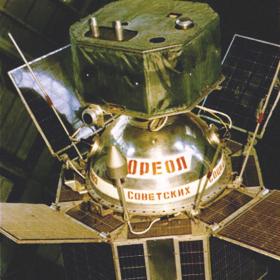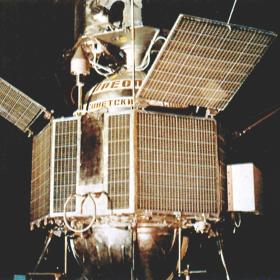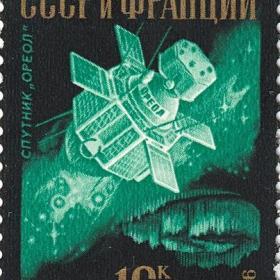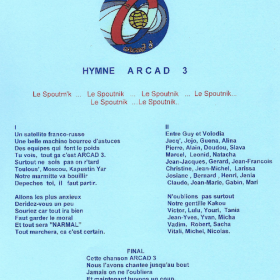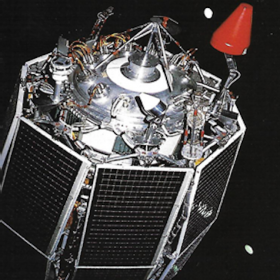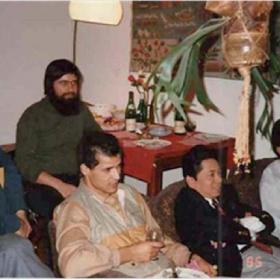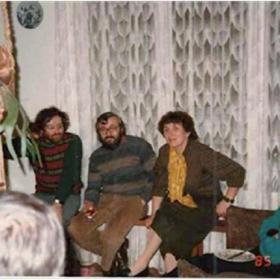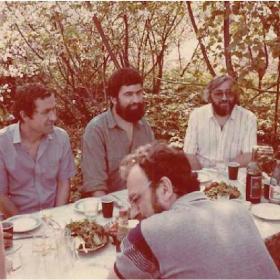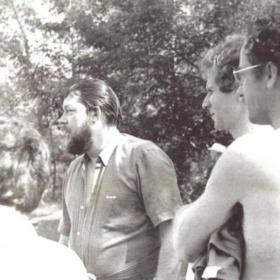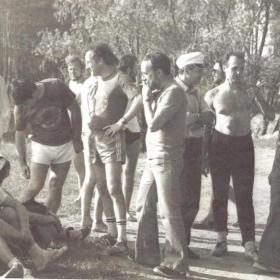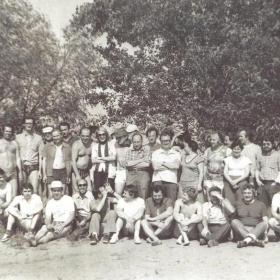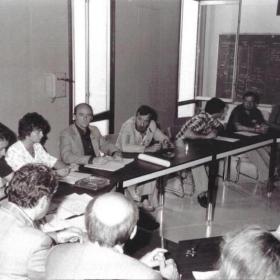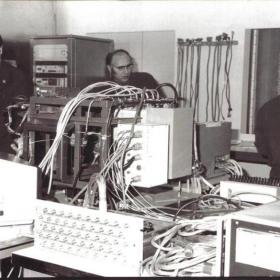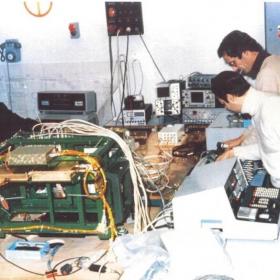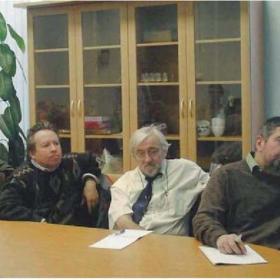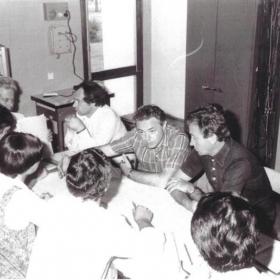
French-Soviet ARCAD-3 project on the basis of Aureol-3 satellite, aimed at studying the interactions between the ionosphere and the magnetosphere.
Scientific Goals
- dissipation of solar wind energy in the ionosphere during magnetospheric substorms and modification of the ionospheric plasma caused by convection, electric currents in the upper polar atmosphere, and particle effusions;
- Small and medium scale structures of longitudinal currents and their influence on the relationship between the magnetosphere, ionosphere, and global electrodynamic processes;
- the role of the ionosphere on the source and acceleration of auroral particles;
- wave-particle interactions.
Mission Overview
In July 1966, during the visit of Charles de Gaulle, the president of France, to the Soviet Union, an intergovernmental agreement was signed between the USSR and France on the scientific and technical cooperation for the peaceful use and exploration of outer space.
One of its outcome was the launch and operation in 1981–86 of Soviet-French project ARCAD (short for Arctic Aurora Density) onboard Aureol-3 satellite (aka Oreol-3; AUREOL-3 is short for AURora and EOLe), aimed at studies of ionosphere-magnetospheric interactions.
Note
Also as part of the ARCAD project, in 1971 and 1973 two satellites were launched, Aureol-1 and -2. Their measurements were correlated with geophysical observations run at Soviet high-latitude observatories in Murmansk, Tiksi, Yakutsk, Mys Shmidta urban locality, on Dikson island, Franz Josef Land (Heiss island). Aureol-1 was launched on December 27, 1971, from Plesetsk cosmodrome with Cosmos-3M launcher. The 348-kg spacecraft was built at Yuzhnoe Design Bureau (Dnepropetrovsk) on the basis of DS-U2 satellite platform and was indicated at the facility as DS-U2-GKA (Russian acronym for "geophysical and complex under the ARCAD project"). Aureol-1 operated in orbit until September 1972. Aureol-2, whose design was similar to that of Aureol-1, was launched on December 27, 1973, and worked until April, 1974.
The Aureol-3 spacecraft was built on the AUOS-3 platform designed by Yuzhnoye Design Bureau specifically for scientific research satellites. It carried the set of scientific instruments to study plasma parameters and properties of elecromagnetic fields.
Basic design of the platform was a sealed cylindrical housing 100 cm in diameter and 260 cm in height containing storage batteries and the main service systems of the satellite. A constant thermal regime was maintained in the enclosure. Eight solar panels with a total area of 12.5 m² were mounted on the outside and opened in flight at a 30° angle to the enclosure. The outside of the hull also housed the instruments and sensors of the on-board systems as well as the radio antennas. Spacecraft was oriented and stabilized with respect to the local vertical with a gravitational stabilizer. The telemetry system provided both control of the spacecraft and channels to receive commands and transmit information to scientific payload.
Scientific instruments were housed in a pressurized compartment at the top of the hull, with its sensors, instruments, and antennas mounted externally on the hull cover and on extendable extensions in flight. The time-programming device and program command decoder included in the satellite's payload made it possible to control the flight and carry on scientific experiments outside the radio visibility range of ground control stations. The ordinary telemetry system of the satellite, which transmitted the results of the measurements, was supplemented with French broadband telemetry system, which ensured real-time transmission of large volume of data to a network of ground stations.
Orbital parameters for Aureol-3
- Type: elliptical
- Inclination: 82,6°
- Period: 108 min
- Apocenter: 1920 km
- Pericenter: 380 km
- Eccentricity: 0,1022
Scientific instruments, operation and control
Project Arcad-3 carried 12 scientific experiments, of which 5 were developed by French laboratories, 4 by Soviet laboratories, and 3 developed jointly by the two countries.
These measurements concerned the electron density and temperature, plasma velocity (charged particles with energy between 0.1 eV and 255 kV, electrons with energy higher than 40 keV, protons of more than 500 keV), the continuous electric and magnetic fields (0 to 10 Hz), the ULF and VLF waves in the spectrum of 001 to 16 kHz, electric fields at the frequencies of 0.1 to 16 MHz and auroral emissions.
- SPECTRO — a set of spectrometers designed to measure the flows of charged particles of small energies:
- ION — energy spectrometer of thermal and superthermal ions
- TBE — measurement of energy spectra of electrons and protons in the range of 10–1000 eV
- ROBE — low energy particle spectrometer (measuring the energy spectra of electrons and protons in the range of 250 eV — 20 keV)
- DYCTION — angular ion spectrum analyzer
- ISOPROBE — a system of radio frequency probes to measure the density of electrons, their temperature and the speed of the plasma (electrons)
- KUKUSHKA — low-energy proton and electron spectrometer
- PIETSTCHANKA — proton and electron spectrometer
- FON — fast electron and proton recorder
- TBF-ONTCH — ultra-low frequency electromagnetic wave meter
- ISO-M — magnetic field sensor
- ISO-F — electrical field sensor
- TRAC — triaxial fluxgate magnetometer
- ALTAIR — optical set of interferometers and photometers
The payload included two instruments for onboard pre-processing of the results: Correlometer, which provided data on the cross-correlation and autocorrelation of the Kukushka and Pietstchanka measurements, and the ONCH-2ME system, which processed the results of the measurements of the TBF-ONCH complex.
The control of scientific experiments onboard Aureol-3 was based on the use of the Soviet control system and the French CN2B onboard electronic computer. The latter, receiving commands in flight, switched the instruments to optimal operating modes depending on the scientific and orbital parameters. Two complementary telemetry systems were used: the Soviet TMS, which used an onboard data recording system, and the French TMF, which provided real-time data transmission to some ground stations.
SPECTRO
Principal Investigator: Dr. Jean-Michel Bosqued, Paul Sabatier University
SPECTRO was developed to study:
- mechanisms of auroral electron acceleration,
- heating and/or acceleration processes of ionospheric ions such as H+, 0+, and possibly He+ and their injection into the magnetosphere,
- the evolution of distribution functions during the interaction of waves and particles in the upper ionosphere,
- structures of large- and small-scale auroral current systems.
The instruments included into the Spectro experiment measured energy and pitch-angle distributions of precipitating and trapped electrons in the energy range of 0.01-21 keV/kV with high temporal resolution, distribution functions of superthermal particles, ionic composition of thermal and superthermal ions. All instruments included in the SPECTRO experiments was controlled by a French onboard CN2B computer, which made it possible to select different modes of operation of the instruments.
The SPECTRO experiment was a complex of spectrometers:
- TBE — the TBE (Very Low Energy) spectrometers were part of the Spectro package. The TBE 01 spectrometer measured electrons and protons in the energy range 10 eV to 1 keV, incident at an angle of 20 deg with respect to the Z axis of the satellite. The TBE 02 spectrometer measured electrons and protons in the energy range 10 eV to 10 keV, incident at an angle of 160 deg with respect to the Z axis of the satellite. Both instruments utilized electrostatic analyzers to select the energy steps.
- TBE 01, a spectrometer for measuring electrons and protons in the energy range from 10 eV to 1 keV, was mounted at an angle of 20 degrees to the satellite's Z axis.
- TBE 02 — the spectrometer measured electrons and protons in the energy range of 10 eV to 10 keV, was mounted at an angle of 160 degrees with respect to the satellite's Z axis.
- ION - the Energetic Ion Spectrometer experiment was part of the Spectro package. It consisted of two identical spectrometers, Ion 01 and Ion 02, that could detect ions in the range 1 to 32 u. A choice of two modes of operation was available by command, a thermal mode (5 to 150 eV/Q) and a suprathermal mode (150 eV/Q to 50 keV/Q). Ion 01 and Ion 02 were oriented at angles of 60 deg and 120 deg, respectively, with respect to the Z axis of the spacecraft, designed to measure the ion composition of inospheric and magnetospheric ions in the range of 0.1 to 14 keV.
- ION 01 - Ion mass-spectrometer, oriented . at an angle of 60 degrees relative to the Z axis of the spacecraft.
- ION 02 - Ion mass spectrometer oriented . at an angle of 120 degrees relative to the Z axis of the spacecraft.
- ROBE – Soft Particle Spectrometer was part of the Spectro package. It measured electrons and protons in the 250 eV to 20 keV range incident at two fixed angles (0 and 90 deg with respect to the Z axis of the spacecraft) and also at seven intermediate angles. A choice of the number of energy steps (8, 16, or 64) and of incidence angles (3, 8, or 9) was available by command.
For further details, see J.-M.Bosqued et al, Ann. Geophys., 38, 567, 1982.
DYCTION
Principal Investigator: Dr. J. J. Berthelier, CRPE, CNRS-CNET/Saint-Maur-des-Fosses
The Spectrometer DYCTION (dynamic-composition and temperature of ions) provided the total density, temperature and velocity of thermal ions. The major ions (H+, and He+ and O+) were measured simultaneously 70% of the time, and the minor ions were measured 20% of the time. These measurements were made in the direction of the satellite velocity vector. The remaining 10% of observation time was used to provide a rough sweep of suprathermal ions at incidence angles ranging from +30 deg to -30 deg in the horizontal (X-Y) plane of the satellite and ranging from +60 deg to -60 deg in the vertical plane of the satellite.
For further details, see J. J. Berthelier el al, Ann. Geophys., 38, 591, 1982.
ISOPROBE
Principal Investigator: Dr. Christian Beghin, CNRS, Centre Spectrometric Nucleaire et Mass
The experiment used two identical probes, ISO 1 and ISO 2, mounted at different angles with respect to the spacecraft velocity vector. The difference between the data from ISO 1 and ISO 2 was used to determine the velocity of the plasma. Each probe consisted of five elements immersed in the plasma. Three elements could be connected to an rf generator, and the other two elements operated as receivers. The probes measured as a function of frequency (100 kHz to 15 MHz) the current flowing between the various transmit-receive pairs of elements. The current exhibited a sharp maximum at the upper hybrid frequency from which the electron density could be calculated. A sharp minimum in the current that was a function of Debye length provided a measurement of the electron temperature.
For further details, see C. Beghin et a.l, Ann. Geophys., 38, 615, 1982.
KUKUSHKA
Principal Investigator: Prof. R. A. Kovrazhkin, Space Research Institute (IKI)
Kukushka — Soft Particle Spectrometer
This experiment consisted of a large-geometric-factor four-channel spectrometer in which incident protons and electrons, each in energy ranges 40-740 eV and 0.76-14 keV, were fed into four electrostatic analyzers. Each of these analyzers could be held at one of, or cycle through, eight energy steps. Energy resolution (delta-E)/E of these steps was 20%. Time resolution for simultaneous measurements in all four analyzers was 10, 80, 320, or 2560 ms according to which memory (ZAP) mode was in use. The instrument's entrance aperture made an angle of 75 deg with the satellite's axis of symmetry which is nominally oriented towards the zenith.
For further details, see Galperin el al, Ann. Geophys., 38, 583, 1982.
PIETSTCHANKA
Principal Investigator: Dr. Rostislav A. Kovrazhkin, Space Research Institute (IKI)
The Pietstchanka spectrometer measured electrons and protons in the energy range 40 keV to 255 keV. This intermediate energy range was measured in five energy bands. This spectrometer was aimed at an angle of 30 deg with respect to the Z axis of the spacecraft.
For further details, see Galperin el al, Ann. Geophys., 38, 583, 1982.
FON
Principal Investigator: A. D. Bolunova, Space Research Institute (IKI)
Detector consisting of two Geiger counters, which measured electrons with energies higher than 40 keV (RI-1) and protons with energies higher that 500 keV (RI-2), mounted at angles of 20 and 90 degrees to the Z-axis of the spacecraft.
For further details, see Galperin el al, Ann. Geophys., 38, 583, 1982.
ONCH-TBF
Principal Investigator: O. A. Molchanov, IZMIRAN, USSR Academy of Science
Principal Investigator: F. Lefeuvre, CRPE, CNRS-CNET/Saint-Maur-des-Fosses, France
The combined Soviet-French ONCH-TBF onboard instrument was designed to allow comprehensive measurments of both electric and magnetic wave fields. The measurements in real-time modes included 5-component wave-form data in the range 10 Hz - 1.5 kHz for 3 magnetic and 2 electric field components, or a wide-band mode in the range 10 Hz - 15 kHz, and several filter banks. In memory modes the data only from several filter-banks in the range from 10 Hz to 16 kHz were recorded. The ONTCH-2ME instrument provided onboard processing of the data from the ISO-F and ISO-M experiments.
For further details, see Berthelier et al., Ann. Geophys., v.38, N5, p.643, 1982
TRAC
Principal Investigator: Jean-Jacques Berthelier
This experiment used a triaxial fluxgate magnetometer primarily intended for spacecraft attitude determination and control, plus extra electronics needed to give magnetic field measurements of sufficient sensitivity and accuracy to study fields associated with field aligned currents. Normal spacecraft systems produced 8-bit magnetic field measurements, corresponding to +/- 200 nT precision. Special electronics (the TRAC system) produced a 12-bit measurement every 43-sec, plus 8-bit digitizations for the differences between N magnetic vectors/sec and the immediately preceding 43-sec digitized value. N ranged between 0.4 and 100 for the four available memory (ZAP) modes. Full magnetic vectors at full time resolution were reconstructed during ground data processing. With this approach, both the time resolution and precision (+/- 5 nT) of the data enable study of field-aligned current phenomena.
For further details see Berthelier et al, Ann. Geophys., 38, 635, 1982
ALTAIR
Principal Investigator: T. М. Mularchik, Space Research Institute (IKI)
The experiment used three photometers (ALTAIR 1, 2, and 3) to measure auroral emissions at 4861 A, 4278 A and 6300 A. The instruments had a viewing angle of 2 deg, and they were aimed at an angle of 160 deg with respect to the Z axis of the spacecraft. A fourth photometer (ALTAIR 4), which had a 1-deg field of view and which was aimed at 28 deg with respect to the Z axis, was used for attitude determination.
For further details, see V. A. Glasyshev et al, Ann. Geophys., 38, 631, 1982.
CORRELOMETER
Principal Investigator: Yu. I. Galperin, Space Research Institute (IKI)
The payload included two instruments for pre-processing results on board: a correlometer, which provided data on the mutual correlation and autocorrelation of Kukushka and Pietstchanka measurements, and the ONTCH-2ME system, which processed the ONCH-TBF complex measurements[6].
For further details, see Yu. I. Galperin el al, Ann. Geophys., 38, 583, 1982.
Mission Results
1982
- Detection of the Getmantsev effect over the ionosphere - nonlinear demodulation by ionospheric plasma in the ionospheric current zone of SW waves emitted by a powerful ground-based heating stand in Tromsø in a coordinated experiment with the Oreol-3 satellite on the active influence on the magnetospheric plasma. This demonstrated that it was possible to create in this way in the ionosphere a huge antenna radiating into the magnetosphere in extra-long wavelengths. Then these results were confirmed on the American satellite DE-1.
1983
- Detection of stimulated emission of energetic electrons and ions trapped in the ring current region under the action of modulated VLF waves (19 kHz) emitted by a powerful ground transmitter in the subauroral latitudes of the European part of the USSR.
1985
- Detection of generation and propagation into the magnetosphere of a strong Alvenov wave after a powerful ground-based chemical explosion (0.3 kt TNT), as well as plasma oscillations and waves (in the 10 Hz - 5 kHz range) in the magnetospheric force tube above the areas of ground explosions. These results were obtained during a series of active coordinated experiments MASSA (magnetosphere-ionosphere coupling in seismoactive phenomena) on the impact on the magnetosphere by acoustic waves from powerful surface chemical explosions. They showed that phenomena at the Earth's surface level and in the lower atmosphere can cause the observed effects in the magnetosphere.
- Detection of intense longitudinal electric currents in auroras with transverse scale of tens and hundreds meters and current densities up to 100 μA/m , corresponding to bright radiant forms of auroras and accompanied by flash of high frequency plasma oscillations near plasma frequency. These results showed that bright auroral forms represent regions of powerful nonlinear plasma processes in the near-Earth space.
1986
- Detection of specific structures of auroral ions emission dispersed by latitude-energy (VDIS-I) arising inside the auroral oval over inverted V type structures, i.e. in magnetic force tubes of plasma layer, at phase of substorm initiation and in 1987 - discovery of similar structures of ion eruption (VDIS-II), but arising near polar boundary of discrete auroral oval at intrusions of ion beams from boundary plasma layer. Discovery and interpretation of VDIS structures were the basis for clarification of magnetosphere structure, establishment of correspondence of its large-scale plasma structures and global picture of auroras.
1987
- Detection of heating of ionospheric ions O+, He+, H+, to tens and hundreds of electron-volts over a region of ionosphere irradiated by powerful ground-based VLF transmitter (19 kHz) in the subauroral zone. These results continued research on the active effects of radiomethods on the ionosphere and magnetosphere.
1990
- Detection from the Oreol-3 satellite of an MHD wave generated by a powerful plasma jet (10 A current of cesium ions) emitted from a rotating MR-12 rocket. This rocket active experiment, conducted from the ship in the Atlantic and coordinated with the Halo-3 satellite, showed new possibilities for the generation of MHD waves and their propagation in the magnetosphere.
Leading Organizations and Principal Investigators
- Council on international cooperation in the field of exploration and use of outer space at the Academy of Sciences of the USSR (Interkosmos Council)
- Centre National D'Etudes Spatiales (CNES), France
- Principal Investigator from the Russian side: Prof. Yuri I. Galperin (IKI)
- Principal Investigator from the French side: Henri Reme, Centre d'Etudes Spatiales des Rayonnements (CESR), France
In Collaboration With
- Space Research Institute, Russian Academy of Sciences (IKI)
- Pushkov Institute of Terrestrial Magnetism, Ionosphere and Radio Wave Propagation, Russian Academy of Sciences (IZMIRAN)
- Polar Geophysical Institute, Russian Academy of Sciences (PGI)
- Leningrad Branch of the Radio Scientific Institute (LONIIR)
- Yangel Yuzhnoe Design Bureau (Dnepropetrovsk, Ukraine)
- Centre national de la recherche scientifique (CNRS), France
- Laboratoire de Physique et Chimie de l’Environnement et de l’Espace (LPC2E)
- CRPE
- Centre d'Etude Spatiale des Rayonnements (CESR)
Main Mission Publications
1982
- MAIN RESULTS OF THE JOINT FRENCH-SOVIET SPACE PROJECT ARCAD-1 AND ARCAD-2 FOR MAGNETOSPHERIC, AURORAL, AND IONOSPHERIC PHYSICS. F. CAMBOU AND YU. I. GALPERIN, Annales de Geophysique, vol. 38, no. 2, 1982, p.87–110.
- THE ARCAD-3 PROJECT. YU. I. GALPERIN, H. REME, C. BEGHIN, J. J. BERTHELIER, J. M. BOSQUED AND B. E. KHMYROV, Annales de Geophysique, vol. 38, no. 5, 1982, p. 543-546.
- THE AUREOL-3 SATELLITE. B. E. KHMYROV, S. S. KAVELIN, A. M. POPEL,I. N. LYSSENKO, Annales de Geophysique, vol. 38, no. 5, 1982, p. 547-555.
- SCIENTIFIC FRENCH AND FRANCO-SOVIET EXPERIMENT CONTROL AND DATA TRANSMISSION ABOARD THE AUREOL-3 SATELLITE. G. HAMEURY, J. CHENE, M. LAMBOLEY, J. MASSAY, Annales de Geophysique, vol. 38, no. 5, 1982, p. 557-565.
- THE LOW ENERGY ELECTRON AND ION SPECTROMETERS ON THE AUREOL-3 SATELLITE — THE SPECTRO EXPERIMENT. J. M. BOSQUED, H. BARTHE, J. COUTELIER, J. CRASNIER, Annales de Geophysique, vol. 38, no. 5, 1982, p. 567–582.
- SUPRATHERMAL PLASMA AND ENERGETIC PARTICLE MEASUREMENTS ABOARD THE AUREOL-3 SATELLITE. YU. I. GALPERIN, M. R. AINBUND, A. D. BOLIVNOVA, V. A. GLADYSHEV, L. S. GORN, Annales de Geophysique, vol. 38, no. 5, 1982, p. 583–590.
- THE THERMAL ION MASS SPECTROMETER ON BOARD AUREOL-3: THE DYCTION EXPERIMENT. J.J. BERTHELIER, J.COVINHES, M. GODEFROY, G. GOGLY,C.GUERIN, D.ROUX, P.THEVENET AND V. A. GLADYSHEV, Annales de Geophysique , vol. 38, no. 5, 1982, p. 591–614.
- THE ARCAD-3 ISOPROBE EXPERIMENT FOR HIGH TIME RESOLUTION THERMAL PLASMA MEASUREMENTS. C. BEGHIN, J. F.KARCZEWSKI,B.POIRIER, R. DEBRIE AND N. I. MASSEVITCH, Annales de Geophysique, vol. 38, no. 5, 1982, p. 615–630.
- AURORAL PHOTOMETERS ABOARD THE AUREOL-3 SATELLITE — THE ALTAIR EXPERIMENT. V. A. GLADYSHEV, A. K. KUZMIN, T. M. MULARCHIK,V. N. ANGAROV, Annales de Geophysique, vol. 38, no. 5, 1982, p. 631–634.
- DC MAGNETIC FIELD OBSERVATIONS ON BOARD THE AUREOL-3 SATELLITE — THE TRAC EXPERIMENT. J.J. BERTHELIER, A. BERTHELIER, YU. I. GALPERIN, V A. GLADYSHEV, G. GOGLY, M. GODEFROY, J. F.KARCZEWSKI. Annales de Geophysique, vol. 38, no. 5, 1982, p. 635-642.
- MEASUREMENTS OF THE VLF ELECTRIC AND MAGNETIC COMPONENTS OF WAVES AND DC ELECTRIC FIELD ON BOARD AUREOL-3 SATELLITE: THE TBF-ONCH EXPERIMENT. J.J. BERTHELIER, F. LEFEUVRE, M. MOGILEVSKY O.A. MOLCHANOV, YU. I. GALPERIN, J. F.KARCZEWSKI, R.NEY, G. GOGLY, C.GUERIN, M.LEVEQUE,J.M.MOREAU AND F.X.SENE, Annales de Geophysique, vol. 38, no. 5, 1982, p. 643–668.
- MAGNETOGYROGRAVITATIONAL SYSTEM OF THREE-AXIS ORBITAL ORIENTATION AND STABILIZATION OF THE AUREOL-3 SATELLITE. V. N. ZIGUNOV, N. G. NOVOSELOVA, L.V. SOKOLOV,V. L. SOLUNIN, Annales de Geophysique, vol. 38, no. 5, 1982, p. 675–682.
- THE INFRA-RED HORIZON SENSOR ON BOARD THE AUREOL-3 SATELLITE. J.J. BERTHELIER, G. GOGLY, M. GODEFROY, C. GUERIN, P. THEVENET, Annales de Geophysique, vol. 38, no. 5, 1982, p. 683–688.
- ELABORATION OF DAILY PROGRAMS AND OPERATIONAL CONTROL OF THE ARCAD-3 SCIENTIFIC PAYLOAD ABOARD THE AUREOL-3 SATELLITE. J. M. BOSQUED, A. DALMAS, J. C. KOSIK, V. A. GLADYSHEV, F. K. SHUISKAIA, Annales de Geophysique, vol. 38, no. 5, 1982, p. 689–696.
- RECEPTION AND RECORDING FACILITIES OF THE FRENCH WIDE-BAND TELEMETRY FROM THE AUREOL-3 SATELLITE FOR THE SOVIET GROUND STATIONS. V.M. BALEBANOV, YU.I. GALPERIN, V.V. LAVRUSSEVICH, V.P. MINAEV, V.N. SKORODUMOV, G.G. BELJAEV, A.M. GOLYAVIN, M.M. MOGILEVSKY, V.V. PANKOV, J.P. SOBOLEV, V.I. DEE, A.A. GALAKHOV, V.E. JUROV AND A.M. PERLIKOV, Annales de Geophysique, vol. 38, no. 5, 1982, p. 697–706.
- ELECTROMAGNETIC COMPATIBILITY BETWEEN SCIENTIFIC INSTRUMENTS IN THE ARCAD-3 PROJECT. J. J. BERTHELIER, Y. V. POLOZOK, V. M. BALEBANOV, C. BEGHIN, P. COUVEIGNES, V. A. GLADYSHEV, J. F.KARCZEWSKI, AND A. I. KOZLOV, Annales de Geophysique, vol. 38, no. 5, 1982, p. 707–712.
- FRENCH-SOVIET DATA PROCESSING SYSTEM FOR ARCAD-3 EXPERIMENT. G. CHARLES, J. DUPIC, M. FERREOL, D. FOURNIER, J. C. KOSIK, V. D. MASLOV, D. MONCHY, V. M. POKRAS AND A. S. VILTCHINSKAYA, Annales de Geophysique, vol. 38, no. 5, 1982, p. 713–723.
1983
- ОБНАРУЖЕНИЕ ВЫСЫПАНИЙ ЧАСТИЦ ИЗ ПОЯСА КОЛЬЦЕВОГО ТОКА, СТИМУЛИРОВАННЫХ МОЩНЫМ НАЗЕМНЫМ ОНЧ ИЗЛУЧАТЕЛЕМ V. Р. А. КОВРАЖКИН, М. М. МОГИЛЕВСКИЙ, Ж. М. БОСКЕ, Ю. И. ГАЛЬПЕРИН, Н. В. ДЖОРДЖИО, Ю. В. ЛИСАКОВ, О. А. МОЛЧАНОВ, А. РЭМ, Письма в ЖЭТФ, том 38, вып. 7, стр. 332–333.
- FIELD AND WAVE MEASUREMENTS ABOARD THE AUREOL-3 SPACECRAFT. J. J. BERTHELIER, A. BERTHELIER, YU. I. GALPERIN, V. A. GLADYSHEV, F. LEFEUVRE, N. I. MASSEVITCH, M. MOGILEVSKY AND O. A. MOLCHANOV, Adv. Space Res, Vol.2, No. 7, pp. 49–52, 1983.
- HIGH RESOLUTION THERMAL PLASMA MEASUREMENTS ABOARD THE AUREOL 3 SPACECRAFT. C. BEGHIN, J. J. BERTHELIER, R. DEBRIE. YU. I. GALPERIN, V. A. GLADYSHEV, N. I. MASSEVITCH AND D. ROUX, Adv. Space Res, Vol.2, No. 7, pp. 61–66, 1983.
- PARTICLE AND OPTICAL MEASUREMENTS ABOARD THE AUREOL 3 SPACECRAFT (ARCAD 3 PROJECT). Adv. Space Res, Vol.2, No. 7, pp. 81–85, 1983:
- A — THE PARTICLE EXPERIMENTS. J. M. BOSQUED, YU. I. GALPERIN, R. A. KOVRAZHKIN, YU. N. PONOMAREV, H. REME, J. A. SAUVAUD AND F. K. SHUISKAYA;
- B — OPTICAL MEASUREMENTS. V. N. ANGAROV, A. GLADISHEV, A. K. KUZMIN, T. M. MULIARCHIK AND J. A. SAUVAUD.
1984
- DIRECT DETECTION OF THE PRECIPITATION OF RING CURRENT ELECTRONS AND PROTONS STIMULATED BY ARTIFICIAL VLF EMISSION. R. A. KOVRAZHKIN, M. M. MOGILEVSKY, O. A. MOLTCHANOV, YU. I. GALPERIN, N. V. DJORDJIO, YU. V. LISSAKOV, J. M. BOSQUED AND H. REME, Geoph Res Letters, Vol. 11, No. 8, pp 705–708, August 1984.
- ВЫСЫПАНИЕ ПРОТОНОВ ИЗ МАГНИТОСФЕРЫ ЗЕМЛИ ПОД ДЕЙСТВИЕМ ИСКУССТВЕННОГО НИЗКОЧАСТОТНОГО ИЗЛУЧЕНИЯ. Р. А. КОВРАЖКИН, М. М. МОГИЛЕВСКИЙ, О. А. МОЛЧАНОВ, Ю. И. ГАЛЬПЕРИН, Н. В. ДЖОРДЖИО, Ж. М. БОСКЕ, А. РЕМ, Письма в ЖЭТФ, том 39, вып. 5, стр. 193–196.
1985
- POSITIVE ION DISTRIBUTIONS IN THE MORNING AURORAL ZONE: LOCAL ACCELERATION AND DRIFT EFFECTS. J. A. SAUVAUD, J. M. BOSQUED, R. A. KOVRAZHKIN,D. DELCOURT, J. J. BERTHELIER, F. LEFEUVRE, J. L. RAUCH, YU. I. GALPERIN, M. M. MOGILEVSKY AND E. E. TITOVA, Adv. Space Res Vol.5, No.4, pp.73–77, 1985.
- STATISTICAL STUDY OF INVERTED-V EVENTS: A COMPARISON BETWEEN EXPERIMENT AND THEORY. J. M. BOSQUED, C. MAUREL, H REME, J. A. SAUVAUD, R. A. KOVRAZHKIN and Yu. I. GALPERIN, Adv. Space Res Vol.5, No.4, pp.135–138, 1985.
- EVIDENCE FOR ION ENERGY DISPERSION IN THE POLAR CUSP RELATED TO A NORTHWARD-DIRECTED IMF. J M BOSQUED , J A SAUVAUD, H REME ,J CRASNIER , YU I GALPERIN, R A KOVRAZHKIN AND V A GLADYSHEV, Adv Space Res Vol.5, No.4, pp.149–153, 1985.
- EXPERIMENTAL EVIDENCE OF PLASMA DUCTS IN THE IONOSPHERIC TROUGH AND IN THE AURORAL ZONE, C. BEGHIN, J. C. CERISIER, J. L. RAUCH, J. J. BERTHELIER, F. LEFEUVRE ET AL., Adv. Space Res Vol. 5, No. 4, pp. 229–234, 1985.
- SMALL SCALE STRUCTURES OF ELECTRIC FIELD VARIATIONS AND PARTICLE PRECIPITATIONS AS OBSERVED ONBOARD AUREOL-3 SATELLITE. E. E. TITOVA, V. E. YUROV, M. M. MOGILEVSKI, O. A. MOLCHANOV, I. G. SHIBAEV, Results of the Arcad 3 project and of the recent programmes in magnetospheric and ionospheric physics, Proceedings of the International Conference, Toulouse, France, Volume: A86-16601 05-46, pp 447–464 Jan. 1985.
- VLF AND ELF EFFECTS IN THE UPPER IONOSPHERE CAUSED BY LARGE SCALE ACOUSTIC WAVES IN THE LOWER IONOSPHERE OBSERVED FROM AUREOL-3 SATELLITE. GALPERIN, YU. I., GLADYSHEV, V. A., JODIO, N. Y., KOVRAZHKIN R. A., LISSAKOV, YU. V. ET AL. Results of the ARCAD 3 Project and of Recent Programs in Magnetospheric and Ionospheric Physics. Proceedings of the International Conference, Toulouse, France, May 22-25, 1984 (A86-16601 05-46). Toulouse, Cepadues-Editions, pp 661–684.
- EARTHQUAKE EFFECTS IN THE IONOSPHERE ACCORDING TO INTERCOSMOS-19 AND AUREOL-3 SATELLITE DATA. V. I. LARKINA, V. V. MIGULIN, M. M. MOGILEVSKY, O. A. MOLCHANOV, Results of the ARCAD 3 Project and of Recent Programs in Magnetospheric and Ionospheric Physics. Proceedings of the International Conference, Toulouse, France, May 22-25, 1984 (A86-16601 05-46). Toulouse, Cepadues-Editions, 1985, p 685–699.
- POLARIZATION OF ELECTROMAGNETIC WAVES RECORDED ON BOARD THE AUREOL-3 SATELLITE. F. LEFEUVRE, J. L. RAUCH,L. V. VOLKOMISKAYA, B. LUNDIN Results of the Arcad 3 project and of the recent programmes in magnetospheric and ionospheric physics. Proceedings of the International Conference, Toulouse, France, May 22-25, 1984 (A86-16601 05-46). Toulouse, Cepadues-Editions, 1985, p. 485-498.
- COORDINATED DATA ON AURORAL ELECTRODYNAMICS FROM GROUND BASED RADAR DIAGNOSTICS AND AUREOL-3 SATELLITE. E. E. TIMOFEEV,V. M. SMYSHLIAEV,N. V. JORJIO, IU. I. GALPERIN, Results of the ARCAD 3 Project and of Recent Programs in Magnetospheric and Ionospheric Physics. Proceedings of the International Conference, Toulouse, France, May 22-25, 1984 (A86-16601 05-46). Toulouse, Cepadues-Editions, 1985, p 949–971.
- STATISTICAL STUDY OF AURORAL ELECTRON PRECIPITATION STRUCTURES DETECTED BY THE AUREOL-3 SATELLITE. J. M. BOSQUED, C. MAUREL, J. A. SAUVAUD, R. A. KOVRAZHKIN, Results of the ARCAD 3 Project and of Recent Programs in Magnetospheric and Ionospheric Physics. Proceedings of the International Conference, Toulouse, France, May 22-25, 1984,. Toulouse, Cepadues-Editions p 49–59.
- UNSTABLE DENSITY GRADIENTS IN THE HIGH-LATITUDE IONOSPHERE. J. C. CERISIER, J. J. BERTHELIER, AND C. BEGHIN Radio Sci, vol.20, p.755, 1985.
- THE ALFVEN WAVES EXCITED IN THE MIDDLE LATITUDE MAGNETOSPHERE BY A LARGE SCALE.ACOUSTIC WAVE WHICH IS PROPAGATED IN THE LOWER IONOSPHERE. GALPERIN, YU. I., GLADYSHEV, V. A., JODIO, N. Y., KOVRAZHKIN R. A., LISSAKOV, YU. V. ET AL. Izv. Earth Phys., 11: 877—884, 1985.
1986
- ARCAD-3 SAFARI-I COORDINATED STUDY OF AURORAL AND POLAR F REGION IONOSPHERIC IRREGULARITIES. J. P. VILLAIN, C. BEGHIN, AND C. HANUISE, Annales Geophysicae p.61-66, 1986.
- IONOSPHERIC RESPONSE TO DAYTIME AURORAL ELECTRON PRECIPITATION - RESULTS AND ANALYSIS OF A COORDINATED EXPERIMENT BETWEEN THE AUREOL-3 SATELLITE AND THE EISCAT RADAR. K. STAMNES, S. PERRAUT,J. M. BOSQUED, M. H. REES, Annales Geophysicae 4(3):235-240, January 1986.
- WAVE CHARACTERISTICS OF LOW-FREQUENCY RADIATIONS RECORDED ON BOARD AUREOL-3 SATELLITE. L. VOLKOMIRSKAYA, S. GORBUNOV, A.E. REZNIKOV, S. PANFILOV, Geomagnetism and Aeronomy 26:628-634, January 1986.
- OBSERVATIONS OF AURORAL ELECTRON INVERTED-V STRUCTURES BY THE AUREOL-3 SATELLITE. J.M. BOSQUED, C. MAUREL, J.A. SAUVAUD, R. A. KOVRAZHKIN, Planetary and Space Science 34(3):255-269, March 1986.
- ИССЛЕДОВАНИЕ КРУПНОМАСШТАБНЫХ СГУСТКОВ ПЛАЗМЫ В НОЧНОЙ АВРОРАЛЬНОЙ ОБЛАСТИ СО СПУТНИКА ОРЕОЛ-3. Ю. И. ГАЛЬПЕРИН, А. А. СЕРОВ, К. БЕГИН, Сборник докладов, стр. 58-61, Суздаль, май 1986.
1987
- SPECTRAL BROADENING OF VLF TRANSMITTER SIGNALS AND SIDEBAND STRUCTURE OBSERVED ON AUREOL 3 SATELLITE AT MIDDLE LATITUDES. Y. TANAKA , M. HAYAKAWA, D. LAGOUTTE, F. LEFEUVRE, Journal of Geophysical Research Space Physics vol.92, issue A7, pp 7551-7559, July 1987.
1988
- ULF Electromagnetic Turbulence in the High-Latitude Topside Ionosphere. J.-J. BERTHELIER, C. MACHARD, J.-C. CERISIER AND A.BERTEHELIER, J. M. BOSQUED, Journal of Geophysical Research, vol.93, NO A6, pp 5701–5712, June 1988.
1989
- THE ARCAD-3 PROJECT AND THE THEORY OF AURORAL STRUCTURES. YU. I. GALPERIN AND A. V. VOLOSEVICH, Canadian Journal of Physics, vol. 67, No 7, pp.719–732, July 1989.
- NON-LINEAR ALFVEN WAVE GENERATOR OF AURORAL PARTICLES AND ELF/VLF WAVES. V. M. CHMYREV, A. BERTHELIER, N. V. JORJIO, J. J. BERTHELIER, J. M. BOSQUED, Yu. I. GALPERIN, R. A. KOVRAZHKIN, C. BEGHIN, M. M. MOGILEVSKY, S. V. BILICHENKO, AND O. A. MOLCHANOV, Planet. Space Sci., Vol. 37, No. 6, pp. 749–759, 1989.
- THE INFLUENCE OF IMF-BZ AND/OR AE ON THE POLAR CUSP: AN OVERVIEW OF OBSERVATIONS FROM THE AUREOL-3 SATELLITE. C. P. ESCOUBET, J. M BOSQUED, Planetary and Space Science 37(5):609–626, May 1989.
1990
- MEASUREMENTS OF FIELD-ALIGNED MOTIONS OF O(+) IONS IN THE SUBAURORAL UPPER IONOSPHERE FROM THE AUREOLE3 SATELLITE. L. V. ZININ,• V. S. SOLOVYEV, YU. I. GALPERIN, S. A. GRIGORYEV, Kosmicheskiye Issledovaniya (Moscow, USSR), v. 28, no. 6, Nov.-Dec. 1990 p 886–889
- MEASUREMENTS OF THE LONGITUDINAL MOVEMENTS OF O(+) IONS IN THE SUBAURORAL UPPER ATMOSPHERE FROM THE AUREOL 3 SATELLITE. L. V. ZININ,• V. S. SOLOVYEV, YU. I. GALPERIN, V. A. GLADYSHEV, S. A. GRIGORYEV, Kosmicheskiye Issledovaniya (Moscow, USSR), v. 28, no. 6, Nov.-Dec. 1990.
1991
- LOW-FREQUENCY MAGNETIC TURBULENCE IN THE HIGH-LATITUDE TOPSIDE IONOSPHERE: LOW-FREQUENCY WAVES OR FIELD-ALIGNED CURRENTS? A BERTHELIER., J.-C. CERISIER,* J.-J. BERTHELIER* and L. REZEAUT, Journal of Atmospheric and Terrestrial Physics Vol. 53. No. 3/4. pp. 333 341, 1991.
- A CASE STUDY OF THE CUSP ELECTRODYNAMICS BY THE AUREOL-3 SATELLITE: EVIDENCE FOR FTE SIGNATURES. J. M. BOSQUED, A. BERTHELIER, J.J. BERTHELIER, C. P. ESCOUBET, Geophysical Research Letters 18(10), Oct 1991.
- THE SMALL-SCALE TURBULENT STRUCTURE OF THE HIGH LATITUDE IONOSPHERE: ARCAD-AUREOL-3 OBSERVATIONS. H. MOUNIR, J.-C. CERISIER, A. BERTHELIER, D. LAGOUTTE AND C. BEGHIN, Annales Geophysicae 9, 725–737, 1991.
1992
- MEASUREMENTS OF LARGE-SCALE IONOSPHERIC PLASMA ENHANCEMENTS AT POLAR LATITUDES FROM THE OREOL-3 SATELLITE. STEPANOV, A. E.; GAL'PERIN, IU. I.; BEGHIN, C.; SEROV, A. A., Kosmicheskie Issledovaniia (ISSN 0023-4206), vol. 30, no. 4, p. 534–542.
1994
- OBSERVATIONS OF POWER LINE HARMONIC RADIATION BY THE LOW-ALTITUDE AUREOL 3 SATELLITE. M. PARROT, Journal of Geophysical Research Atmospheres 99(A3):3961–3969, March 1994.
1997
- OPPOSITE ION DISPERSIONS OBSERVED QUASI‐SIMULTANEOUSLY IN THE POLAR CUSP BY THE DE‐2 AND AUREOL‐3 SATELLITES. C. P. ESCOUBET, J. M. BOSQUED, R. A. HOFFMAN, A. BERTHELIER, R. C. ANDERSON, Geophysical Research Letters, 24(20), October 1997.
1998
- ON A POSSIBILITY OF PARAMETRIC AMPLIFIER IN THE STRATOSPHERE-MESOSPHERE SUGGESTED BY ACTIVE MASSA EXPERIMENTS WITH THE AUREOL-3 SATELLITE. YU. GALPERIN, MASASHI HAYAKAWA, Earth Planets and Space 50(10):827–832, October 1998.
1999
- STATIONARY MAGNETOSPHERIC CONVECTION ON NOVEMBER 24, 1981. 1. A CASE STUDY OF ``PRESSURE GRADIENT/MINIMUM-B''AURORAL ARC GENERATION. Y. I. GALPERIN AND J. M. BOSQUED, Ann. Geophysicae 17, 358– 374, 1999.
- EXPERIMENTAL TEST OF A HOT STRATIFICATION THEORY FOR INVERTED-V EVENTS USING AUREOL-3 OBSERVATIONS. E. E. ANTONOVA, O. LUIZAR, J. M. BOSQUED, R. A. KOVRAZHKIN, Advances in Space Research 23(10):1675–1678, December 1999.
- MULTIPLE INVERTED-V STRUCTURE EVENTS OBSERVED AT AUREOL-3 SATELLITE AND HOT PLASMA STRATIFICATION THEORY. M. STEPANOVA, O. LUIZAR, E. E. ANTONOVA, J. M. BOSQUED, Revista Geofisica 50:65–71, January 1999.
2000
- EXPERIMENTAL STUDY OF THE FORMATION OF INVERTED-V STRUCTURES AND THEIR STRATIFICATION USING AUREOL-3 OBSERVATIONS. O. LUIZAR, M. V. STEPANOVA, J. M. BOSQUED, E. E. ANTONOVA, R. A. KOVRAZHKIN, Ann. Geophysicae 18, 1399–1414, 2000.
2002
- MORPHOLOGY OF HIGH LATITUDE AURORAL ELECTRON PRECIPITATIONS OBTAINED BY THE AUREOL-3 SATELLITE. M. STEPANOVA, O. LUIZAR, E. E. ANTONOVA, J. M. BOSQUED, Advances in Space Research 30(12):2719–2724, December 2002.
2003
- IONOSPHERIC TURBULENCE ASSOCIATED WITH SEISMIC ACTIVITY FROM AUREOL-3 SATELLITE DATA. Y. HOBARA, M. PARROT, F. LEFEUVRE,O. A. MOLCHANOV, EGS - AGU - EUG Joint Assembly, Abstracts from the meeting held in Nice, France, 6–11 April 2003, abstract i.
2004
- AZIMUTHAL PLASMA PRESSURE RECONSTRUCTED BY USING THE AUREOL-3 SATELLITE DATA DURING QUIET GEOMAGNETIC CONDITIONS. M. STEPANOVA, E. E. ANTONOVA, J. M. BOSQUED, R. A. KOVRAZHKIN, Advances in Space Research 33(5):737–741, March 2004.
2005
- LOW-LATITUDE IONOSPHERIC TURBULENCE OBSERVED BY AUREOL-3 SATELLITE. Y. HOBARA, F. LEFEUVRE, M. PARROT, OA MOLCHANOV, Annales Geophysicae 23(4), June 2005.
Gallery
